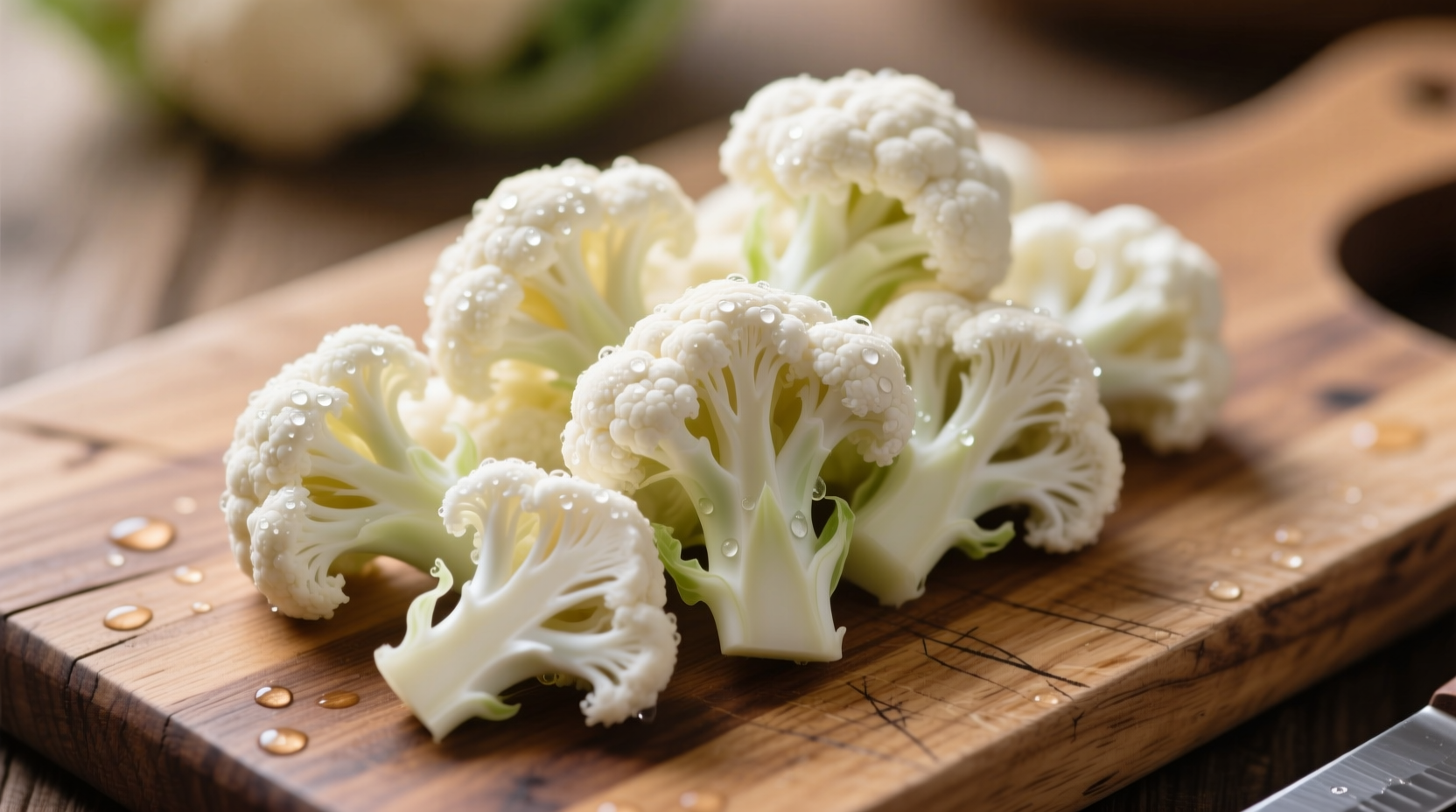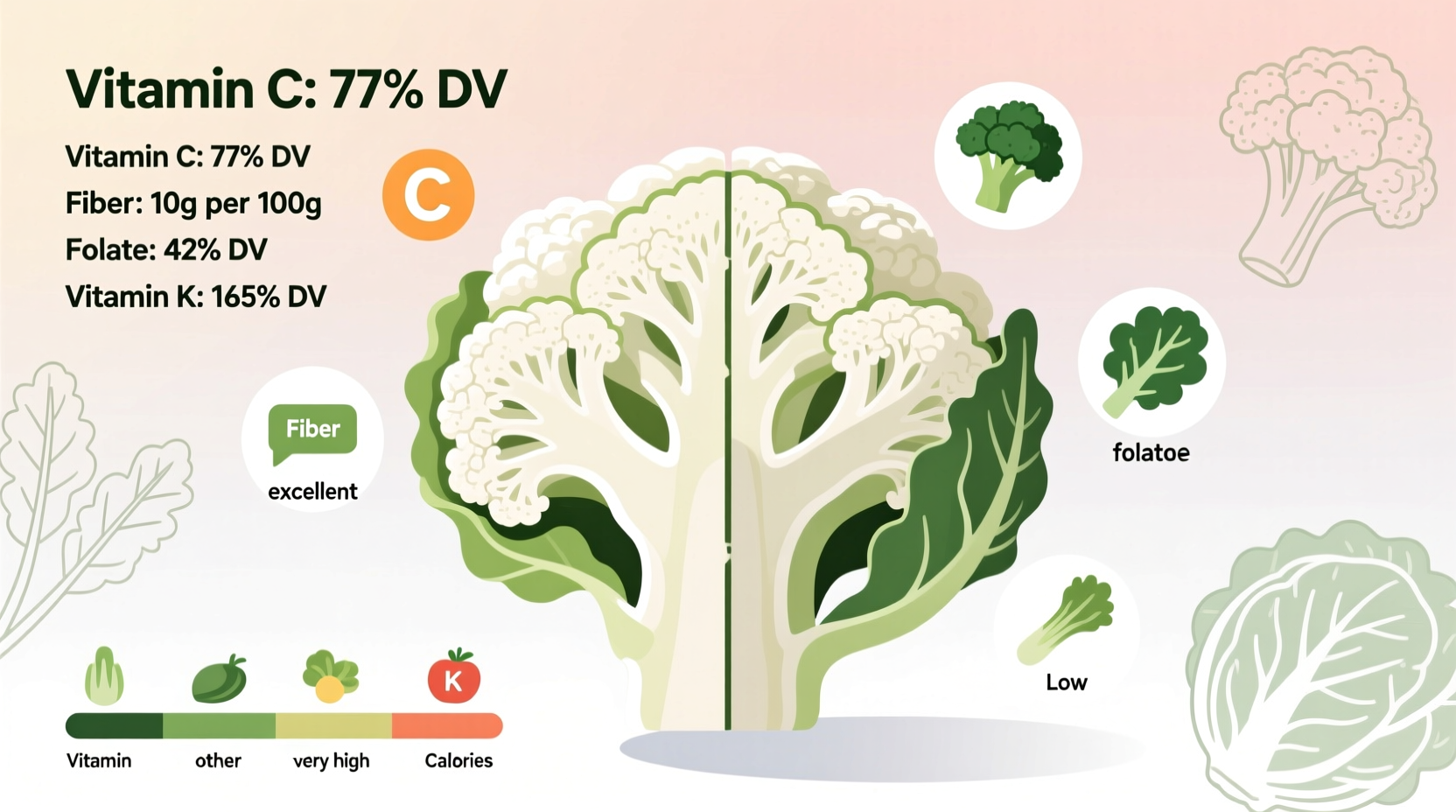Discover why raw cauliflower deserves a regular spot in your diet. This nutrient-dense vegetable packs more vitamin C than oranges by weight and delivers powerful phytochemicals that cooking can diminish. Whether you're managing weight, boosting immunity, or seeking anti-inflammatory foods, raw cauliflower offers remarkable nutritional advantages that make it a superfood worth incorporating into your daily meals.
Raw Cauliflower Nutritional Profile at a Glance
Understanding the precise nutritional composition helps you maximize the health benefits of this versatile vegetable. The table below shows key nutrients in 100g of raw cauliflower (approximately 1 cup chopped):
| Nutrient | Amount per 100g | Daily Value % |
|---|---|---|
| Calories | 25 kcal | 1% |
| Carbohydrates | 5 g | 2% |
| Dietary Fiber | 2 g | 7% |
| Protein | 1.9 g | 4% |
| Vitamin C | 48.2 mg | 80% |
| Vitamin K | 15.5 mcg | 13% |
| Folate | 57 mcg | 14% |
| Potassium | 299 mg | 9% |
| Manganese | 0.15 mg | 7% |
Data sourced from USDA FoodData Central, the authoritative government database for food composition information.
Why Raw Cauliflower Offers Unique Health Benefits
Consuming cauliflower in its raw form preserves heat-sensitive nutrients and bioactive compounds that provide distinctive health advantages. The enzyme myrosinase, which converts glucosinolates to cancer-fighting sulforaphane, remains fully active when cauliflower isn't cooked. Research published in the Journal of Agricultural and Food Chemistry confirms that raw cruciferous vegetables deliver higher levels of these protective compounds compared to cooked versions.
Raw cauliflower nutrition supports multiple body systems simultaneously. The high vitamin C content (more than oranges by weight) strengthens immune function while promoting collagen production for healthy skin. The substantial fiber content—nearly 3 grams per cup—feeds beneficial gut bacteria and helps regulate blood sugar levels, making it an excellent choice for those managing diabetes or seeking sustained energy throughout the day.

Raw vs. Cooked: Nutritional Differences You Should Know
Understanding how preparation methods affect cauliflower's nutritional profile helps you make informed dietary choices. While both raw and cooked cauliflower offer health benefits, specific preparation methods impact different nutrients:
- Vitamin C: Raw cauliflower retains 100% of its vitamin C, while boiling can reduce levels by up to 50% according to research from the National Institutes of Health
- Sulforaphane: Raw consumption provides maximum cancer-protective compounds, as heat deactivates the myrosinase enzyme needed for conversion
- Carotenoids: Light cooking (steaming) can increase absorption of certain fat-soluble compounds by breaking down cell walls
- Digestibility: Some people find cooked cauliflower easier to digest, especially those with sensitive digestive systems
This context boundary matters significantly for individuals with specific health goals. Those seeking maximum anti-cancer compounds should prioritize raw consumption, while people focusing on mineral absorption might benefit from light steaming.
Practical Ways to Incorporate Raw Cauliflower Into Your Diet
Transforming raw cauliflower from bland to brilliant requires simple preparation techniques that enhance both flavor and nutritional uptake. Try these evidence-based approaches:
Romantic Raw Preparation Methods
For optimal nutrient retention and flavor development:
- Chop and wait: Cut cauliflower into florets and let sit for 40 minutes before eating to maximize sulforaphane formation
- Add mustard seed: Sprinkle ground mustard seed (which contains active myrosinase) on raw cauliflower to boost sulforaphane production
- Pair with healthy fats: Combine raw cauliflower with avocado or olive oil to enhance absorption of fat-soluble vitamins
- Create nutrient-dense salads: Mix raw cauliflower with lemon juice (for vitamin C preservation) and nuts (for added minerals)
Who Should Moderate Raw Cauliflower Consumption
While raw cauliflower offers impressive nutritional benefits, certain individuals should consider context boundaries. People with thyroid conditions may want to moderate raw cruciferous vegetable intake due to goitrogen content, though research from the American Thyroid Association indicates typical dietary amounts pose minimal risk for most individuals.
Those with irritable bowel syndrome (IBS) or sensitive digestive systems might experience bloating from raw cauliflower's raffinose content. If this applies to you, start with small portions (¼ cup) and gradually increase as your tolerance develops. The FODMAP research from Monash University confirms that cauliflower in moderate portions (75g) remains low-FODMAP for most people.
Maximizing Your Raw Cauliflower Experience
For the best flavor and nutritional payoff, select fresh cauliflower with tight, creamy-white florets and bright green leaves. Store it stem-side down in a perforated plastic bag in your refrigerator's crisper drawer, where it will maintain peak nutrition for 1-2 weeks.
When preparing raw cauliflower, avoid soaking it in water as this can leach water-soluble nutrients. Instead, gently wipe florets with a damp cloth. For enhanced flavor development, try massaging raw cauliflower with lemon juice and sea salt for 5-10 minutes before serving—this technique breaks down some tough fibers while preserving nutrients.











 浙公网安备
33010002000092号
浙公网安备
33010002000092号 浙B2-20120091-4
浙B2-20120091-4